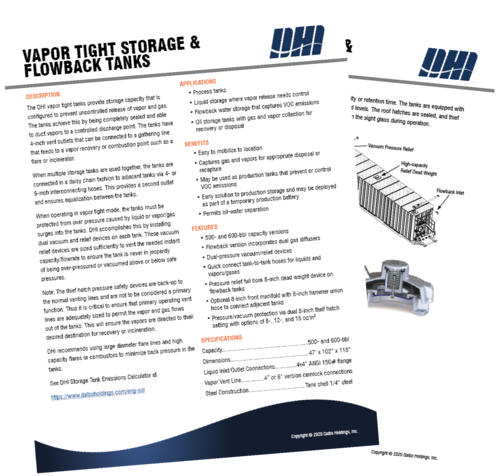Vapor Tight Storage & Flowback Tanks
Vapor Tight Flowback Tanks
Vapor tight tanks are designed to hold a pressure of 32 oz/sq.in, which is considered a positive pressure atmospheric tank. The pressure relief systems supplied by DHI are typically set at 16 oz/sq.in, venting to atmosphere.
The tanks are normally vented via dual 6-inch line to a larger diameter flare header (10-inch recommended) flowing to a combustion flare/burner. For atmospheric dispersion, vapor recovery equipment may be employed to further reduce emissions.
The DHI flare system is designed specifically for use with these tanks in the vapor tight configuration as it is designed to minimize back pressure on the tank, providing a large diameter throat to safely incinerate vented gas. The flare is equipped with adequately sized flame-arresting devices. The vent flowline must be equipped with blowback prevention devices if DHI flares are not used.
The tanks come in two configurations: with and without gas diffusion devices. The units with diffusion equipment are designed to be the receiving tanks. These tanks have additional dead-weight relief devices to prevent any surge from causing risk to the tanks’ integrity.
H2S Service Operations
The DHI vapor tight system can be configured for H2S (sour) service. The tank liners are resistant to H2S, with upgrades to H2S-resistant coating and 316 stainless steel components. These upgrades permit the vapor tight configuration to operate without risk of accelerated deterioration. They also prevent the release of H2S bearing gasses onsite and pipe to the flare system for safe combustion and residual dispersion to the atmosphere.
Pressure & Vacuum Relief
The purpose of the thief hatch is to work in tandem with the vent valve to minimize the escape of light ends of crude in the storage tanks by maintaining a blanket pressure in the tanks. A vacuum relief function is also standard to prevent a suction or draw down event from collapsing the tank. The thief hatch permits access to the contents of the tank for sampling and level gauging.



